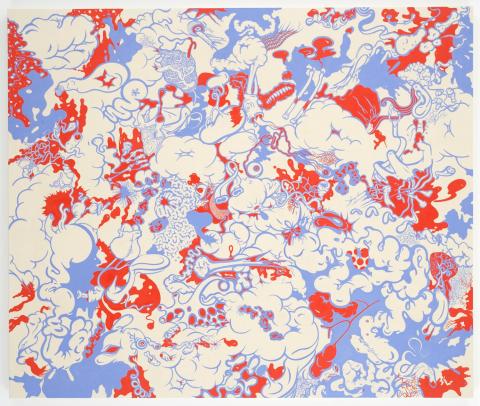
A Bonanza at Boston’s Institute of Contemporary Art
The Institute of Contemporary Art on Boston’ waterfront is an ambitious museum and, so far, its reach has not exceeded its grasp. Case in point, the two exhibitions installed within weeks of each other, plus a showing of new acquisitions. It’s a bonanza for museum goers.
Figuring Color opened in February and will be on view through May 20. The paintings and works on paper by German artist Charline von Heyl will be around until July 15.
The four artists represented in “Figuring Color” couldn’t be more different. Not only do they work in different media, but also different colors. The only thing they have in common is that “color is used to evoke a physical representation of the body that becomes increasingly emotional as you move through the galleries,” says Senior Curator Jenelle Porter.
The precise, small-scale ceramic sculptures by Kathy Butterly in the first gallery are rendered in pinks and soft colors that give them a disarming sweetness that belies their serious intent. They’re arranged like objects in a jeweler’s case, which adds to the impression that they’re just pretty to look at.
In fact, Butterly’s art is conceived with a hard edge. “They are all self-portrait of a sort,” she says. “More Plenty” from 2006 reflects on our materialistic culture. Objects spill out of the container.
A translucent red bead curtain the height and the length of the gallery by Felix Gonzales-Torres, “Untitled” (Blood) (1992), physically and emotionally separates Butterly’s work from the paintings of Sue Williams, which feature floating body parts. Williams’s paintings are her response to U.S. military involvement in Iraq and Afghanistan. Porter points out that “American Enterprise,” painted In red, white and blue by Williams in 2009, presents a collage of human organs – the human body politicized and ravaged in the name of freedom and patriotism.
The fourth artist in the exhibition, Roy McMakin, is an accomplished furniture-maker. He has converted furniture to sculpture through a process of conceptualization that changes the meaning of chair, table, chest of drawers, etc. by altering scale or arrangement or attributes. His 2003 work, called “Lequita Faye Melvin” after his mother, comprises 19 pieces of furniture painted medium gray. He says that the pieces may be arranged in any configuration. “They are gra,” he says, “because that is the color I always saw them in. Gray seemed like memory, and [is] ultimately reflective of the sadness I think is contained within them.”
The exhibition catalogue includes an essay by Porter and poems by 22 writers, including John Ashbery and Cole Swensen, on the idea of color.
The most recently mounted exhibition is a solo show of works created by Charline von Heyl in the past five years. Her strong abstract images possess a vitality that emanates from bold strokes of color and sharp geometric shapes that reflect the artist’s own energy. She attributes this to the fact that her canvases are “painted backwards.” By that she means that she paints the shapes in the foreground first, then fills in the background.
In contrast to her canvasses, von Heyl’s mostly black-and-white collage works on paper incorporate some recognizable images – a hand in one frame, lips and chin in another. They are so unlike her canvases, however, that she requires a different studio to make them. She says that the change is liberating.
“Figuring Color” and von Heyl’s images give viewers a sampling of the range of ideas being explored in art at the beginning of the 21st century.

